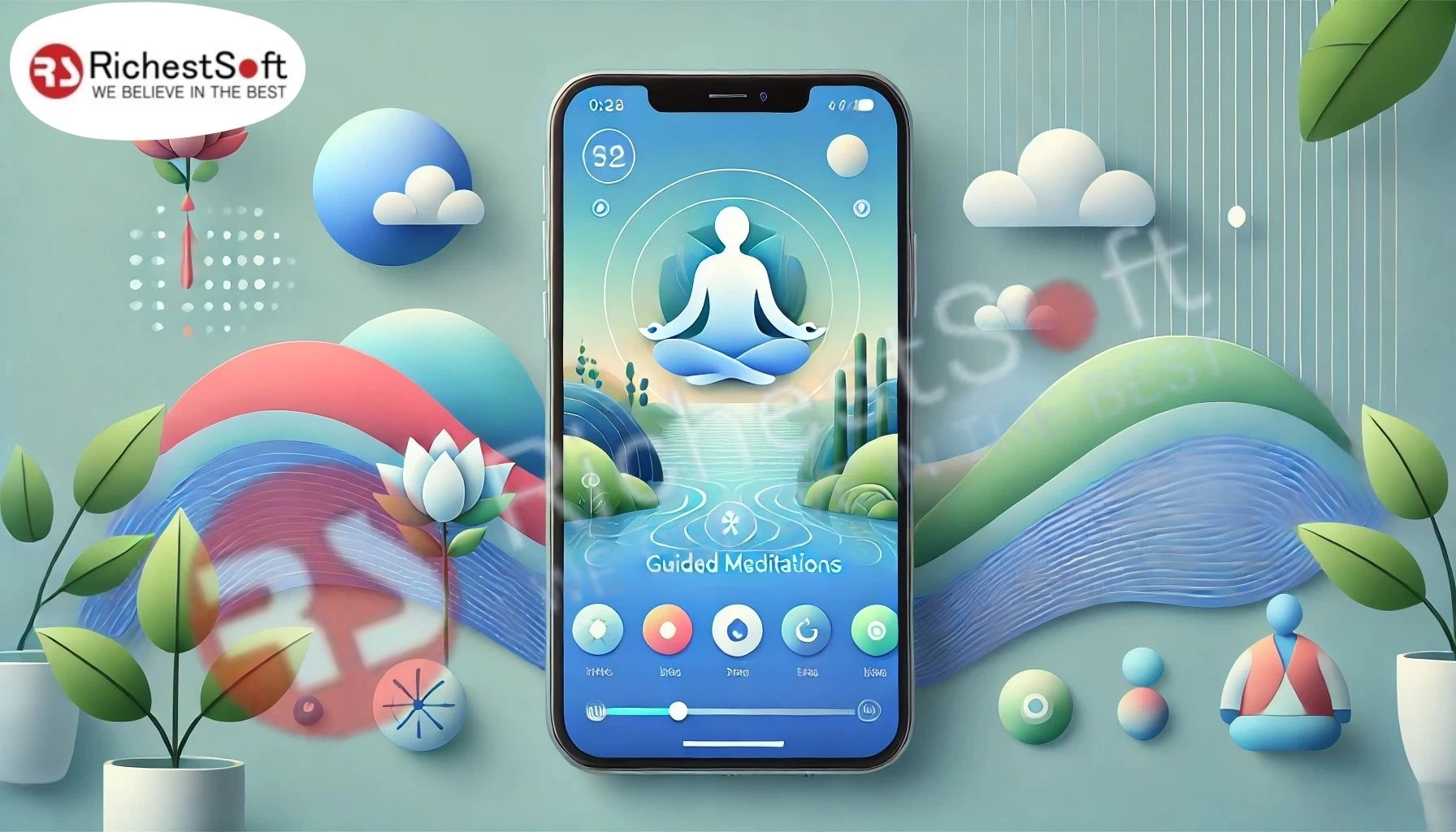December 24, 2024
When people start taking the “importance of 20 minutes of meditation” seriously, your vision of providing them with meditation apps must be executed today. Meditation applications help people continue living healthy lifestyles.
The study says the expected revenue of meditation apps can grow at an annual rate of 7.72%, leading to a projected market volume of US$7.41bn by 2029.
Developing meditation apps comes with stifled challenges that need to be overcome before initiation. The biggest one is when apps like Headspace and Calm are already leading the market, so why would people prefer yours?
This is where well-renowned app development companies come into play, staging result-oriented strategies to develop apps like Headspace and Calm that drive results.
In this blog post, we will delve into the development process of meditation apps like Headspace and Calm and learn how your app could be a catalyst for your business growth.
Why Develop Meditation Apps like Headspace and Calm?
Individuals constantly look for ways to relax and find peace. Meditation apps like Calm and Headspace have emerged as powerful platforms to help people cope with stress and anxiety-like challenges.
Moreover, developing meditation app clones saves time. Building from scratch would delay the launch. Thus, creating similar apps has become necessary for several reasons.
The significant reason is the growing demand for mental wellness. People want accessible solutions to boost their mental peace. These apps offer guided sessions in the form of videos, articles, and audio. Whether at home, work, or on the go, they help users find moments of calm in their busy lives.
Such apps are also available for Android and iOS. Android app developers and iOS experts help users enhance their mental health with science-backed techniques. These apps are simple to use, encouraging beginners to get started.
Headspace and Calm apps offer various programs, such as breathing exercises, stress-relieving sessions, and sleep aids. Such tech-driven apps help people integrate meditation into their busy routines.
Top Features of Meditation Apps Like Headspace
Understand what makes Headspace unique and the choice of many. Here are the essentials you can’t miss:
- Onboarding
Introduce users to meditation with a short, simple tutorial. For beginners, this quick walkthrough explains how the app works and eases them into their first session.
- Relaxing Design
The app’s design should reflect peace and focus, using calming colors like blue, green, yellow, or soft pastels. It should also be minimal and clean—no clutter, just content. Smooth, subtle animations must set the mood, not distract.
- Personalized Profiles
Profiles let users customize their journey. Users can track preferences and meditation goals. The app suggests sessions based on their habits with ML tech. Game app development company adds gamification to meditation platforms, engaging users to engage badges for daily streaks and boosting retention.
- Meditation Session Sets
The app offers high-quality sessions in podcast-like formats, combining calming voices, music, or nature sounds. It includes beginner packs for topics like stress, focus, and sleep.
- Play Screen
Design a minimal play screen with a big, smooth “Play” button as the focal point. Add serene background visuals like landscapes or gradients and enhance sessions with nature sounds for added calm.
- Discovery Screen
The app’s dedicated “Discover” screen keeps users curious, exhibiting trending packs, new sessions, and fresh content. To encourage subscriptions, the app offers free trial sessions.
- Push Notifications
Engage users with timely updates- remind them of their next session, announce new packs, discounts, or features, and encourage daily streaks with gamified reminders.
Leading Features for Your Meditation App, like Calm
Focus on these key features to create a successful meditation app like Calm. They are the foundation of a smooth, user-friendly experience.
- Sign-Up
Let users sign up using email, social media, or Google. It is important for paid features and personal info.
- Onboarding
Guide new users with a simple tutorial. Ask questions like, “How do you feel?” or “Why meditate?” It helps customize the experience.
- User Profile
Include basic info like preferences, subscription details, and meditation stats. Only ask for what you need.
- Navigation Menu
Use clear icons for different types of meditation, such as sleep, focus, or movement. This will help users find the best option for their needs.
- Settings
Wearable apps allow users to adjust preferences, customize recommendations, and connect wearables. Give them control over the experience.
- Content Library with Search
Organize audio and video content with a search bar and filters. Help users find the right meditation quickly.
- Player
Add a simple player for both online and offline listening. Let users pause, skip, or adjust playback.
- Favorites
Include a “Favorites” section in the library so users can bookmark their favorite meditations for easy access later.
- Recommendations
AI apps suggest content based on users’ past choices, keeping them engaged and retained.
- Gamification
Add fun elements like points, timers, badges, and leaderboards to keep users motivated.
- Push Notifications
Use notifications to remind users to meditate, share new content, or offer encouragement.
- Calendar
Let users schedule meditation sessions. This helps them plan and stay on track.
- Payments
Enable users to pay for premium content directly in the app using options like Google Pay, Apple Pay, or credit cards.
- Wearable Integration
Sync with wearables to track sleep and offer personalized recommendations based on data.
Epilogue: Essential Features of Trending Meditation Apps
Building a meditation app requires in-depth research on leading platforms like Headspace and Calm. Professional developers understand essential facets that meditation apps must include. Here are the required features:
- Simple Sign-Up & Login
Start with a seamless onboarding experience. Allow users to sign up quickly using email, social media, or phone numbers. Keep it smooth, fast, and frustration-free.
- Personalized User Profiles
After registration, let users create profiles with relevant details: preferences, meditation goals, subscriptions, and personalized session settings. Keep it minimal—ask what is structurally necessary to enhance their experience.
- Engaging Intro Tutorials
Help beginners get started with visually engaging and concise tutorials. Highlight meditation basics, exercises, and easy-to-follow steps so users can navigate the app confidently.
- Meditation Programs & Courses
Offer diverse meditation programs, from beginner-friendly sessions to advanced content. Like Headspace, consider providing free starter courses (e.g., ten sessions) to ease users into the experience and unlock premium programs as they progress.
- “Explore More” Tab
Inspire curiosity with an ‘’Explore More’’ button that showcases trending courses, popular programs, and updates tailored to user interests—all in one place.
- Push Notifications
Keep users in the loop with timely push notifications about new features, offers, subscriptions, or updates. A gentle nudge can boost engagement and encourage consistency.
Factors to Consider for App Development like Headspace and Calm
Creating a successful meditation app relates to major factors as defined below:
- Define your Idea: Decide on the type of app, like a yoga app or a guided sleep meditation app.
- Choose the Right Platform: Develop an app for Android, iOS, or both.
- Use AR/VR Technology: It improves relaxation and stress relief.
- Design with Care: Keep the design simple with calm colors and subtle details.
- Add Gamification: Reward users with badges and scores to keep them engaged.
- Offer Diverse Programs: Regularly update your meditation content to keep users interested.
- Monetization: Use subscriptions, purchases, or ads to generate revenue.
Development Steps of Meditation Apps like Calm or Headspace
Developing applications like popular meditation apps requires specific steps. It will help if you prefer professional assistance. Here are simple steps to begin with.
- Market Research and Competitive Analysis
Start by researching the market. Understand trends and growth rates and compare them with leading apps. Pay attention to their design, features, customer communication, and marketing.
- Defining The App’s Unique Selling Proposition (USP)
Developers help you decide the app type to create—guided meditation, mindfulness, or a community app. Focus on what will set your app apart. This could be personalized features or e-commerce options. Make it unique!
- Planning and Strategy
Outline your business idea. What problem does your app solve? Who is your audience? What is your market and competition? Plan your app’s functionality, design, and promotion. Remember your monetization strategy, such as subscriptions or in-app purchases.
- Design and User Experience
Design matters. Keep it flawless. Avoid bright colors or clutter. Focus on calm, minimalism, and clear fonts. Make it peaceful for your users.
- Development and Architecture
Pick the right technology. Professional app developers recommend React Native for cross-platform apps, which saves time and money. Start with core features: login, registration, search, progress tracking, in-app payments, and user profiles.
- Create a Prototype
Prototypes come in three levels: low-fidelity, medium-fidelity, and high-fidelity. Low-fidelity prototypes show the app’s basic layout and functionality. Medium-fidelity prototypes allow users to test more detailed designs to check navigation. High-fidelity prototypes are almost identical to the final app and are used in later stages to test usability and identify issues. They help predict how users will interact with the app.
- Launch a simple MVP (Minimum Viable Product)
This approach saves costs and helps you quickly analyze user behavior before adding advanced features. A basic MVP might include sign-in, user profiles, an intro course, a small library of meditation sessions, and gamification. After launching, continuously test and gather feedback to guide future updates and improvements.
- App Deployment and Marketing
Once your app is ready, developers test it. Check functionality, usability, and performance. Then, it can be deployed to the App Store and Google Play. Begin your marketing campaign.
- Ongoing Maintenance and Updates
Keep your app fresh by regularly updating it with new features and content. Listen to user feedback, track analytics, and improve the app. Engage with your community for continued growth.
Development Cost of Meditation Apps
The cost of building a meditation app depends on several factors. Platform choice (iOS, Android, or PWA) and app functionality affect the price. The more features to insert, the higher the cost.
To get an accurate estimate, discuss every detail with your app development team.
Expect to pay between $10k and $50k for a basic app. The cost of a fully featured app could be more.
How to Monetize Your Meditation App
Apps like Headspace and Calm thrive on premium subscriptions. Calm even requires credit card details before users can finish registering, so monetization is key if you’re creating a meditation app.
Ways to Make Money from Meditation Apps Like Calm or Headspace:
- Subscription: Many apps, especially startups, use this model. They offer a free trial (usually 1-2 weeks) to users along with premium packages.
- Pay-per-download (PPD): It is rare. Users pay once to download the app.
- Advertising: If your app receives a lot of traffic, you can display ads and earn money from brands’ cost-per-click charges.
- In-App Purchases: Users buy extra content, like personal plans, meditation lessons, or unique tracks, within the app.
Wrapping Up!
The growing popularity of meditation, fueled by successful apps like Headspace and Calm, highlights the potential value of creating a meditation app. By entering this market, you can positively impact users’ lives, with both anecdotal and scientific evidence supporting its benefits.
To succeed, approach the project strategically. Begin by deeply understanding your target audience’s goals, needs, and motivations. Study your competitors and the services they offer. Identify the unique value your app can deliver.
Your budget will influence many decisions, including whether to develop the app in-house or partner with a tech expert. It’s wise to collaborate with experienced professionals who can build your app quickly and efficiently, minimizing risks that could increase time and costs.
Amplify Your Business Footprints with Digitization!
Connect with RichestSoft’s app development maestros and help people transform their lives at their fingertips. Contact us today!
 +1 315 210 4488
+1 315 210 4488 +91 99888 06489
+91 99888 06489






